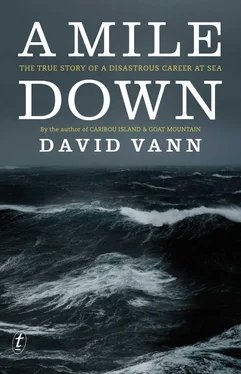“Sorry,” I said. “I’m not going to be able to do that. I need the time to cut the dinghy free.” Then I left the radio. Maybe I should have gone for the small, light inflatable dinghy on our aft deck. It was tied with only one line, which would have been easy to remove. But I went for the larger dinghy, hanging off the davits on the stern. It was bigger and far more stable, and new. It had our boat name on it and would be easier to spot. But it was also 350 pounds, a fiberglass hull with inflatable tubes, so it was more difficult to manage.
I untied the lines that were keeping it from swaying back and forth, and as soon as I did that, it swayed hard. We were rolling even in the little six-foot waves, and we were also heeling strangely from the water coming in below, the stern sinking first. Then I unfastened a clip on the bow that was difficult to reach. I swung a bit as we rolled on a wave, and I was out over the water, my feet kicking in the air.
Nancy yelled at me to be careful. I freed the clip and got my feet back on deck. Then I loosened the reels that held the main davit lines, and they spun out dangerously, like fishing reel handles running free. That dropped the dinghy into the water, but each time our hull came up on a wave the dinghy was yanked by the davit lines. So I cut the davit lines, which put me out over the water again, and pulled the dinghy around toward the side boarding ladder.
The boat was heeling far over to port as it sank, because of the open porthole we’d used for the bilge pump, which meant that the boarding ladder on the starboard side was high out of the water and getting higher, with Nancy on it. She threw in the paddles and then she was ready to jump, but her jump was going to be five or six feet at least, and if she missed, she’d be in the water.
“Stop!” I yelled. “This is wrong. Too dangerous. I’ll bring it around to the other side.”
I pulled the dinghy aft, but the waves were yanking it from me. I was having a difficult time controlling its two short lines, afraid I would lose them and we’d have no dinghy. Then I thought I should let VISAR know we were abandoning ship, so I tried to wrap the lines around the starboard mizzen shroud, one of our steel rigging wires, and asked Nancy to hold them.
As soon as I left her, though, I could tell she wasn’t going to be able to hold on. I ran back to her and tied the lines around the wire.
The radio, when I got to it at the helm, was dead. The system must have shorted out because of the flooding. The boat was getting low in the water, especially the port stern, and it was heeling over and wallowing in sick ways.
“The radio’s dead,” I told Nancy. “Hopefully they’re coming for us.”
I tried to untie the lines for the dinghy, but they were constantly yanked. A black nylon line and a blue sheathed polyester line. The blue line was for the bow, the most important, but I had to cut both lines to get them free, and that left the black line the longest. I remember staring at the colors, blue and black, feeling a bit confused, the knife seeming to take an awfully long time to cut through, the huge boat beneath me sagging like an old horse on its haunches, the deck getting steeper. When I finally sawed through, I grabbed the black line and just held on. The blue line was in the water.
I pulled the dinghy aft to the stern. I had meant to make it all the way around to the port side, because that’s where Nancy was waiting with the ditch bag, but I realized I might not make it there in time. And the rail beside her was almost in the water, instead of ten feet off the water, as it should have been. The boat was going to sink to port, so if we tried to get into the dinghy there, the boat might roll over onto us.
“We’re going off the stern!” I yelled to Nancy.
“The stern?” she yelled. “Where?” She was panicking, finally, as the boat went down.
“Over here!” I yelled. “Right here!” She was only fifteen feet from me, but there was all this stuff in her way on the aft deck: a big fifty-five-horse outboard motor, heavy and dangerous; a green kayak filled with four heavy dive tanks; our enormous round white fenders, over fifty pounds each; our extra chain spilled out onto the teak from its bucket; boards and paddles and other gear. I was suddenly very afraid she might not be able to climb over all of it, afraid the boat could roll over right then and I’d lose her.
I was having a difficult time holding the dinghy, too, the black line yanking hard in my hands as I watched her come toward me. “Drop the lifejackets!” I yelled. “Just get over here!”
She looked confused, but she dropped the two extras she was holding, held onto the ditch bag, and made it to me. Then she was ready to jump into the dinghy.
I tried to time it with the waves, waited until a wave brought the dinghy up close to us. “Okay, jump!” The dinghy fell away, and Nancy fell down farther than I had wanted, onto her knees, but she made it.
“I’m all right!” she yelled.
“Okay, scoot forward!” Our deck was dipping lower on each wave, until when I finally jumped, our stern was only a few inches off the water. In the summer, kids on one of the charters had jumped off the stern over and over, squealing in delight because it had been so high.
I grabbed a paddle. Nancy was just looking at the boat.
“We have to paddle,” I said. “We can’t be near it when it sinks. We could get hit by a mast or the davits.”
We worked hard to pull away from the stern. We just kept going until we were about a hundred yards away, then we heard a helicopter coming in fast, the U.S. Coast Guard.
The helicopter hovered directly over us, about fifty feet in the air. There was a guy in a jumpsuit hanging out the side with his thumb up, asking us, I supposed, if we were okay. So I put my thumb up to say we were all right.
The stern of our boat was getting lower as it rocked in the waves, the bow sticking up. It looked beautiful, the new cream-colored paint, the new varnish on the rails and pilothouse, the name in wedding script on the bows, the dark blue bottom paint. It was a gorgeous boat. Nancy found the digital camera in the ditch bag and snapped a couple of photos.
The helicopter had been circling and came in close now, approaching from downwind. They had something dangling in a plastic case.
“It must be a radio,” I told Nancy. “We’re supposed to catch it.”
I held my hands up, showing I was ready to catch, and Nancy did the same. Having my hands up made me realize how much we were getting rocked in the waves. I had to put one hand down to hold on.
The helicopter brought the radio right to me, the pilot impressive.
The Coast Guard wanted to know if anyone else was onboard, and I reassured them no one was. They said the VISAR rescue boat would arrive in about twenty minutes, and I told them we could wait. They said there was also a cutter on its way, and a merchant vessel. I could see the merchant vessel a few miles east of us. It was huge. I didn’t want to be rescued by the cutter or the merchant vessel. I knew from getting on the freighter in Moroccan waters how dangerous it can be to board a big ship in waves.
“This is Bird of Paradise ,” I called on the radio. “We would like to be rescued by VISAR. We do not want to try to board the cutter or the merchant vessel. I repeat, we request rescue in the smaller, twenty-two-foot VISAR boat, because it will be much safer and easier.”
I didn’t hear a response. There were a lot of conversations about us on channel 16, the voices overlapping, all of them difficult for me to hear: VISAR, the Coast Guard helicopter, Coast Guard San Juan, the Coast Guard cutter, the merchant vessel, and maybe even a salvage company. Coast Guard San Juan was giving an ETA for the cutter arrival, VISAR was giving its ETA to Coast Guard San Juan, and the Coast Guard helicopter was going back and forth with the merchant vessel, trying to get it to stay farther away. It was threatening to run us over, heading straight at us from upwind.
Читать дальше












